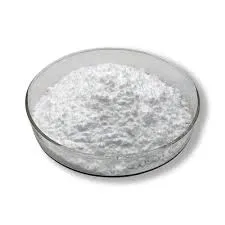
Nov . 16, 2024 17:30 Back to list
uses of hydroxypropyl methylcellulose
The Versatile Uses of Hydroxypropyl Methylcellulose
Hydroxypropyl methylcellulose (HPMC) is a widely used cellulose derivative that boasts a variety of applications across different industries. This semi-synthetic polymer is characterized by its non-toxic nature, excellent film-forming ability, and solubility in both cold and hot water. Due to these unique properties, HPMC has become an invaluable ingredient in fields such as pharmaceuticals, construction, food, and cosmetics.
Pharmaceutical Applications
In the pharmaceutical industry, hydroxypropyl methylcellulose is primarily employed as a binder, thickening agent, and coating agent in the formulation of tablets and capsules. Its ability to form a gel when mixed with water allows for controlled release of active ingredients, making it particularly advantageous for sustained-release formulations. This property not only enhances the effectiveness of medication but also improves patient compliance by reducing the frequency of dosing. Additionally, HPMC is used as an excipient in ophthalmic preparations and artificial tears, aiding in lubrication and moisture retention in the eye.
Construction and Building Materials
HPMC has gained popularity in the construction industry for its role as a thickening agent and water-retaining agent in mortar, cement, and plaster. Its incorporation into these building materials enhances workability, improving the ability to spread and mold the substances. Furthermore, HPMC adds to the durability of the mixtures by preventing them from drying too quickly, which is crucial for ensuring proper curing and bonding. The use of hydroxypropyl methylcellulose in construction not only optimizes material performance but also contributes to the overall longevity of structures.
Food Industry Uses
uses of hydroxypropyl methylcellulose

In the food sector, HPMC is recognized for its role as a food additive, where it serves as a thickener, emulsifier, and stabilizer in various products. It aids in improving the texture and shelf-life of food items, especially in gluten-free formulations, where it acts as a binding agent to enhance the dough's elasticity. HPMC is commonly found in sauces, dressings, dairy products, and baked goods, providing a desirable mouthfeel and consistency. Its ability to retain moisture also helps in preventing spoilage, making HPMC an essential component in modern food processing.
Cosmetics and Personal Care
Hydroxypropyl methylcellulose is widely used in cosmetics and personal care products due to its emulsifying and thickening properties. It is commonly found in creams, lotions, and gels, where it helps to stabilize formulations and enhance product viscosity. HPMC functions as a film-forming agent, ensuring that products maintain their integrity and provide a smooth application. Additionally, its non-irritating nature makes it suitable for sensitive skin formulations, further expanding its use in skincare products.
Environmental Considerations
An important aspect of hydroxypropyl methylcellulose is its biodegradable nature, which has drawn attention in the context of environmental sustainability. As more industries focus on reducing their ecological footprint, HPMC stands out as a renewable resource that can replace synthetic additives in many applications. This shift towards biodegradable alternatives is particularly relevant in packaging and the development of eco-friendly products.
Conclusion
In summary, hydroxypropyl methylcellulose is a multifaceted material with an extensive range of applications in various sectors. Its beneficial properties, such as film-forming ability, solubility, and non-toxicity, make it indispensable in pharmaceuticals, construction, food, and cosmetics. As industries continue to evolve and seek sustainable solutions, the demand for HPMC is likely to grow, reinforcing its status as a vital ingredient in modern formulations. Whether improving health through drug delivery, enhancing building materials' performance, or providing texture in food and cosmetics, HPMC’s versatility ensures its role remains significant in a variety of fields.
-
Versatile Hpmc Uses in Different Industries
NewsJun.19,2025
-
Redispersible Powder's Role in Enhancing Durability of Construction Products
NewsJun.19,2025
-
Hydroxyethyl Cellulose Applications Driving Green Industrial Processes
NewsJun.19,2025
-
Exploring Different Redispersible Polymer Powder
NewsJun.19,2025
-
Choosing the Right Mortar Bonding Agent
NewsJun.19,2025
-
Applications and Significance of China Hpmc in Modern Industries
NewsJun.19,2025







